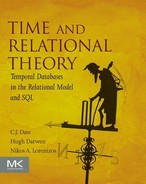Part I A Review of Relational Concepts
This book assumes a basic familiarity with the relational model. Thus, this first part is intended merely as a quick refresher course on that model; in effect, it summarizes, and serves as a reference source for, material you’ll be expected to know when we get to the temporal discussions in Parts II, III, and IV. It consists of three chapters:
Of course, tutorials on the relational model and related matters can be found in many places (see, e.g., references [28], [42], and [45]); thus, if you’re familiar with any of those references, you probably don’t need to read this part of the book in detail. However, if your knowledge of the relational model derives from other sources—especially ones based on SQL—then you probably do need to read these chapters fairly carefully, because they emphasize numerous important topics that such sources typically don’t. Such topics include:
■ “Possible representations,” selectors, and THE_ operators
■ Relation values vs. relation variables
■ The fundamental role of constraints
■ Less well known but important operators such as EXTEND, MATCHING, and NOT MATCHING
and many others.
Note: Chapter 1 also introduces the suppliers-and-shipments database, which serves as the basis for almost all of the examples in later chapters. Even if you decide just to skim this part of the book, therefore, you should at least take a look at that sample database before moving on to Part II.
